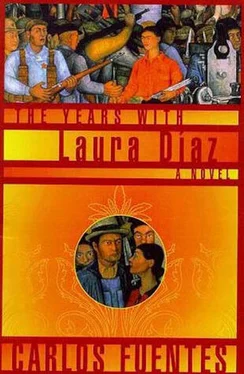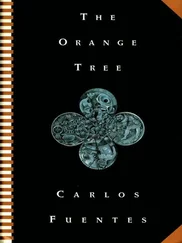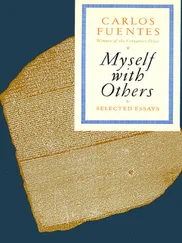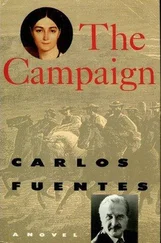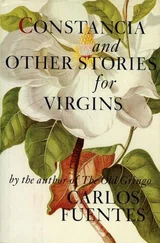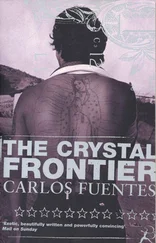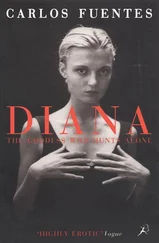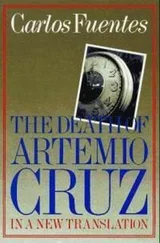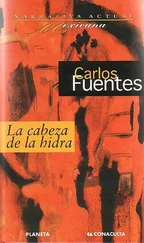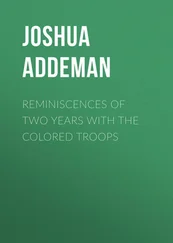(Elizabeth, child, don’t shame me.
(There’s nothing to be done about it. God, with your help, made me this way.)
She hadn’t recognized Laura just as Laura hadn’t recognized her, either because Laura — glancing at herself in the mortuary mirror — had changed just as much, or perhaps Elizabeth actually had recognized her but didn’t want to say hello because resentment, however old, was still alive. Or perhaps to avoid comparisons, lies, you haven’t changed a bit! How do you do it? Made a pact with the devil? The last time, in Ciro’s in the Hotel Reforma, Elizabeth had looked like an anorexic mummy.
Laura Díaz waited for Elizabeth Garcia to separate from Laura Rivière before approaching her namesake, offering her hand, receiving one that was dry, fine, and then she tried to recognize her in the depth of the black veil, in the very well-cared-for white skin below the cylindrical, low hat crowning her head instead of the languid ash-blond hair-cut of her youth.
“I’m Laura Díaz.”
“I’ve been waiting for you. You promised to call me.”
“I’m sorry. You told me to save myself.”
“Did you think I couldn’t help you?”
“You told me yourself, remember? It’s too late for me. I’m a prisoner. My body’s been captured by routine.”
“But if I could escape from my own body …” Laura Rivière smiled. “I detest it. That’s what I told you, you probably remember …”
“I’m sorry I didn’t call you.”
“So am I.”
“You know? We might have been friends.”
“Hélas.” Laura Rivière sighed. Then she turned away from Laura Díaz with a melancholy smile.
“She really loved Artemio Cruz,” Orlando Ximénez confided to Laura as he took her back to Avenida Sonora, threading their way through the rubble of the city. “She was a woman obsessed by light, lamps, light in interiors, yes, the proper arrangement of lamps, the exact wattage, how to illuminate faces. She’s her own self-portrait.”
(I can’t go on, my love. You have to choose.
(Be patient, Laura. Just realize … Don’t force me …
(To do what? Are you afraid of me?
(Aren’t we fine just as we are? Is something missing?
(Who knows? Artemio. It may well be that nothing’s missing.
(I didn’t deceive you. I didn’t force you.
(I didn’t transform you, which is different. You’re not ready. I’m getting tired.
(I love you. As I did the first day.
(It’s no longer the first day. No longer. Make the music louder.)
As she was getting out of the taxi, Orlando tried to kiss her. Laura felt the touch of those wrinkled lips, the nearness of that skin which looked like graph paper, like a weak, pink piece of meat on the grill. And she felt it repellent. She pushed him away, disgusted and shocked.
“I love you, Laura. As I did the first day.”
“It’s not the first day anymore. Now we know each other. Far too well. Goodbye, Orlando.”
And the mystery? Will they both die without Orlando’s ever revealing his secrets? Orlando, intimate friend of the first Santiago in Veracruz; Orlando, seducer of Laura because of that; mysterious mailman between the invisible anarchist Armonía Aznar and the world; Orlando, her lover and her Virgil in the infernal circles of Mexico City. It was impossible to attribute any mystery whatsoever to this out-of-fashion lounge lizard, mummified and banal, who had gone with her to Carmen Cortina’s wake, to the burial of an entire era in the history of Mexico City. She preferred to hold on to the mystery. The homage to “old times” nevertheless left Laura with a bitter taste in her mouth.
The electricity had been restored. She began to pick up fallen objects, pots and pans in the kitchen; she straightened up the dining room, then especially the living room, and the balcony where, when the family reconciled after Laura Díaz’s passion for Jorge Maura, she and her husband Juan Francisco, her sons Santiago and Danton, and the ancient auntie from Veracruz, María de la O, had watched the afternoons fade in the Bosque de Cohapultepec. She replaced the books knocked off their shelves. Out from between the pages of Bertram D. Wolfe’s biography of Diego Rivera had fallen the photograph Laura Díaz took of Frida Kahlo the day she died, July 13, 1954. The day Laura left Harry Jaffe alone in Tepoztlán and raced to the Riveras’ house in Coyoacán.
“Here,” Harry said, handing her a Leica. “I used it to take stills in Hollywood. Don’t come back without bringing me Frida Kahlo dead.”
She had restrained the rage Harry sometimes aroused in her. Frida was dying, amputated and ill, but even on her deathbed she’d gone on painting — right to the last moment. Harry was dying in a tropical valley, but he was too cowardly to pick up pen and paper. The main reason why Laura took the photo of Frida’s body was to show it to Harry and tell him, “She never stopped creating, not even on the day she died.”
But now Harry, too, was dead. So was Carmen Cortina, and the rage Laura felt toward Harry, like the sense of absurdity she felt seeing Carmen Cortina’s embalmed body, was turning, as she stared at the photo of Frida dead, into something more than love or admiration.
In her coffin, Frida Kahlo showed off her black hair braided with colored ribbons. Her ring-covered fingers and her arms laden with bracelets rested on a bosom decked out for the final journey in sumptuous necklaces of thin gold and silver from Morelia. Her pendant earrings of green turquoise no longer hung from her earlobes but lay at rest like her, mysteriously retaining the dead woman’s final warmth.
Frida Kahlo’s face did not change in death. Her eyes were closed but seemed alert, thanks to the inquisitive vivacity of her thick unbroken eyebrows, her trademark, that dangerous and fascinating whip. The thickness of her brows did not succeed in masking Frida’s mustache, the notorious and notable down on her upper lip that made you think that a penis, the twin of Diego’s, might be trying to spring up between her legs to confirm the probability, not just the illusion, that she was a hermaphrodite, and parthenogenic to boot, able to fertilize herself and generate with her own semen the new being that her feminine half would bear thanks to the vigor of her masculine half.
That’s how Laura Díaz photographed her, for Laura thought she was taking the picture of an inert body, not realizing that Frida Kahlo had already set out on the journey to Mictlan, the Mexican Indian underworld you can reach only if you are guided by three hundred ixcuintles, those hairless dogs Frida collected which now, motherless, were howling disconsolately on the patios and in the kitchens and on the roof terraces of the funeral home.
Frida Kahlo’s recumbent position was a deception. She was heading for Mictlan, an inferno that resembled a painting by Frida Kahlo but without the blood, the spines, and the martyrdom, without the operating rooms, the scalpels, the steel corsets, the amputations, without the fetuses — a hell only of flowers, of warm rains and hairless dogs, a hell piled high with pineapples, strawberries, oranges, mangos, guanábanas , mameys, lemons, papayas, zapotes , where she would arrive on foot, humble and haughty at the same time, with a sound body, cured, prior to hospitals, virgin of all accidents, greeting Señor Xolotl, ambassador of the Universal Republic of Mictlan, Chancellor and Plenipotentiary Minister of Death, that is, of THIS PLACE. How do you do, Señor Xolotl: that’s what Frida would be saying as she entered hell.
She entered hell. From her house in Coyoacán they took her, dead, to the National Palace of Fine Arts. There she was draped with the Communist flag, an act that led to the dismissal of the Institute director. Then she was brought to the crematorium: she was put into the oven — all decked out, dressed, bejeweled, with beribboned hair, the better to burn. And when the flames sprang up, Frida Kahlo’s body sat up, sat up as if she were going to chat with her oldest friends, the Caps group whose practical jokes had scandalized the National Preparatory School in the 1920s; as if she were getting ready to talk once again with Diego; that’s how Frida’s body sat up, animated by the crematorium flames. Her hair flamed like a halo. She smiled one last time at her friends, and dissolved.
Читать дальше
